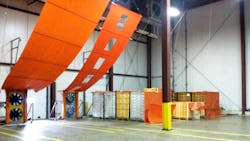Recooling berries can produce a harvest of efficiency, productivity
The United States Department of Agriculture (USDA) recently allowed blueberries from Chile to be fumigated on arrival at US ports. This offers exporters that are unable to fumigate at country of origin an alternative so they can ship. It also creates a need to recool those berries immediately.
Not all US port cold storage facilities or nearby 3PLs (third-party logistics providers) have pre-coolers, which can be used for recooling berries. But for those that do, the ability to quickly and thoroughly remove heat from fruit, and thus preserve shelf life and salable weight while reducing the need for repacking, is a benefit they can provide to their customers—and in some case, retailers themselves.
“Recooling is different than pre-cooling,” according to Jim Still, founder and president of Global Cooling Inc, which invented and manufactures both the Jet-Ready and Rapid-Cool pre-coolers and recoolers. Global’s factory is at the Philadelphia Navy Yard industrial complex, near PHL airport and all the ports of Philadelphia and South Jersey.
“With pre-cooling, usually a large amount of refrigeration capacity is needed in conjunction with the forced-air system or tunnel, because of the need to remove all of the field heat from the produce,” said Still. “But with recooling, we are only removing the heat gained by bringing the commodity back up from ideal storage temperature to one at which the methyl bromide is effective, according to the USDA requirements.
“Often, this recooling refrigeration load is only 10 to 15 degrees Fahrenheit,” he said, “instead of the 40 to 50 degrees we have to deal with when fully pre-cooling. In almost all instances, one or several of our Jet-Ready instant Pre-Coolers can be put into operation for recooling, and no additional refrigeration equipment is needed. For a very, very small investment, a cold storage operator can get into the recooling business almost overnight.”
DLJ Produce in Long Beach CA is using three Jet Pre-Coolers to recool berries this season, after having started with recooling Chilean grapes in 2014.
Mike Asdoorian, head of operations for DLJ, said, “We’ve had great results using the Jets to recool berries early this season.” With labor issues constricting the amount of imported fruit currently passing through West Coast ports, “we can handle a lot more berries and grapes than we are running at present,” he said.
DLJ has also cooled apples and other commodities, noting that the Jet Pre-Coolers are portable and can be easily moved from a room running at one temperature into a different room running at another temperature.
In the Philadelphia area, Global’s pre-coolers are used by a number of service providers for recooling both grapes and berries. These include Lucca Cold Storage, Manfredi Cold Storage, and Diamond State Port Corp at the Port of Wilmington DE. Two of the companies also use Global’s Rapid-Cool 2- and 3-tier pre-coolers, which offer even faster pulldown times as well as the benefits of reversing airflow during recooling.
For more information, see www.Pre-Coolers.net.

